
Poker is a card game played with five cards, two distinct pairs of cards, and one high card. The highest pair wins in a tie. However, the highest pair also wins if the second pair has a high card. In a tie, the highest card wins if neither pair has a pair or better hand, and a high card can also break a tie with a better than pair or straight. Here are the basic rules of poker.
Basic rules of poker
Several online poker websites have made it easy to learn the basic rules of poker. These include the dealer button, who deals cards, and the order of cards revealed. Whether the cards are revealed face down or face up, the players can choose to muck or fold. As the name implies, the last aggressor is the player who placed the last wager. To make sure that the player who placed the last bet has the last turn, they must mark their hand with the dealer button.
Variants of poker
There are several variations of the poker game. Poker is divided into three major families based on how it is played and how the cards are distributed. The cards are shared between all players or they are private. They are either open or closed and visible only to the player who has them, or they are hidden. Winning hands can be high, low, or a combination of both. Some variations impose additional rules based on the types of hands.
Betting procedures
The game of poker centers around the process of betting. To increase the speed of play, minimize confusion, and ensure security, betting procedures have evolved. Although there are minor variations in etiquette between different cardrooms, poker players generally follow basic rules. Learn more about poker betting procedures below. To avoid confusion and maximize the fun of the game, stick to the rules. Here are some of the most common kinds of bets:
Limits of bets and raises
In no-limit and pot-limit games, the minimum bet is usually the big blind. When a player raises, he or she must make an equal bet to the previous bet. In this case, the minimum raise is $5, and the player must raise at least that amount. If a player raises by more than twice that amount, the bet must be at least $15, and it must be at least the same amount as the previous raise.
Bluffing in poker
If you’re playing poker, one of the most important techniques is bluffing. Bluffing is a way to get your opponents to fold to your bets. The more aggressive you are, the more likely your opponents are to call you out. But don’t go overboard. Don’t get caught bluffing unless you’re confident that you’re going to win the pot. In poker, bluffing is a skill you can develop over time.
Royal Flush in poker
A Royal Flush is the best possible poker hand in many games, but you must remember that it is not a sign of luck, but a true smile of fortune. Every card contestant dreams of achieving a Royal Flush once in their career. While it is possible to have this combination, you must play right and avoid other players’ passes. This will help you bring your game to a showdown and reveal your opportunities to your opponents.
Tie hands in poker
When two players have identical five-card combinations, a tie occurs. Two players who have two pairs of sevens may tie. The winner of a tie is the player with the higher pair. However, ties can also occur when two players have pairs of twos or threes. If the board texture is certain, it may increase the chances of a tie. If this happens, both players will be removed from the final betting round.
Insurance in poker
In poker, insurance is an optional side bet that players may choose to make if they don’t think they will win the pot. In exchange for the premium, players get a percentage of the pot in exchange for insuring their hand. Although it can be tempting to play without insurance, it’s not always a wise decision. While insurance is popular in games like blackjack and Texas Hold’em, it’s rare in other poker variants.